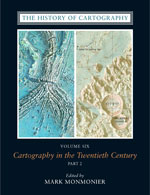Ordering Information
Free Online Access
 The twentieth century is a pivotal period in map history. The transition from paper to digital formats led to previously unimaginably dynamic and interactive maps. Geographic information systems radically altered cartographic institutions and reduced the skill required to create maps. Satellite positioning and mobile communications revolutionized wayfinding. Mapping evolved as an important tool for coping with complexity, organizing knowledge, and influencing public opinion in all parts of the globe and at all levels of society. Volume 6 covers these changes comprehensively, while thoroughly demonstrating the far-reaching effects of maps on science, technology, and society—and vice versa.
The twentieth century is a pivotal period in map history. The transition from paper to digital formats led to previously unimaginably dynamic and interactive maps. Geographic information systems radically altered cartographic institutions and reduced the skill required to create maps. Satellite positioning and mobile communications revolutionized wayfinding. Mapping evolved as an important tool for coping with complexity, organizing knowledge, and influencing public opinion in all parts of the globe and at all levels of society. Volume 6 covers these changes comprehensively, while thoroughly demonstrating the far-reaching effects of maps on science, technology, and society—and vice versa.

The lavishly produced volume includes more than five hundred articles accompanied by more than a thousand images. Hundreds of expert contributors provide original research, often based on their own participation in the developments they describe, and interpretations of larger trends in cartography. Designed for use by both scholars and the general public, this definitive volume is a reference work of first resort for all who study and love maps.
Volume Six contains 1,960 pages, 805 color plates, 119 halftones, 242 line drawings, and 61 tables.
Volumes Four, Five, and Six are structured as large, multi-level, interpretive encyclopedias. They are similar in page size and general appearance to the first three volumes of the History, with the same density of illustrations but with full color reproductions.
Reviews
Black, Jeremy. Journal of European Studies 45, no. 5 (2015)
PDF of Review
Black, Jeremy. Journal of World History, 27, no. 1 (2016)
PDF of Review
Dodge, Martin. Imago Mundi, 69, no. 1 (2017)
PDF of Review
Eades, Gwilym. Cartographic Journal, 53, no. 1 (2016)
PDF of Review
Freitag, Ulrich. Kartographische Nachrichten, 66, no. 3 (2016)
PDF of Review
Haines, Elizabeth. Journal of Historical Geography (2016)
PDF of Review
Hennig, Benjamin. Globe, no. 78 (2015)
PDF of Review
Laskow, Sarah. AtlasObscura.com (2015)
PDF of Review
Schröder, Iris. H-Net Review, (2016)
PDF of Review
Seemann, Jörn. AAG Review of Books, 4, no. 3 (2016)
PDF of Review
Verma, Hentrietta. Library Journal (August 2015)
PDF of Review
Watson, Ruth. IMCoS Journal, no. 144 (2016)
PDF of Review
Zellmer, L. R. Choice 53, no. 6 (2016)
PDF of Review
About the Editor
Mark Monmonier is a university professor and writer working in Upstate New York. He teaches courses on map design, geographic information policy, environmental hazards, and map history at Syracuse University’s Maxwell School of Citizenship and Public Affairs. He has been teaching at Syracuse University since 1973, and in 1998 they promoted him to Distinguished Professor. Fascinated by innovative mapmaking technologies and the growing diversity of map uses, he writes books that explore the impact of cartography on society, focusing on the twentieth century.
Website: http://www.markmonmonier.com/
Associate Editors
Peter Collier, formerly with Portsmouth University, United Kingdom, is an expert in military and topographical mapping in the nineteenth and twentieth century. He is active in the International Cartographic Association Commission on the History of Cartography. Collier was also a major contributor to Volume 6.
Karen S. Cook is a Special Collections Librarian in the Kenneth Spencer Research Library, University of Kansas, responsible for books and manuscripts from the Old World. Dr. Cook is an expert in the history of map printing technologies and has contributed to Volumes 4, 5, and 6.
A. Jon Kimerling is Professor Emeritus of Geography, Environmental Sciences, and Marine Resource Management at Oregon State University. He has also been the editor of Atlas of the Pacific Northwest since 1979.
Joel L. Morrison is a national and international leader in the areas of cartography and management of spatial data. He received his MS and Ph.D. from the University of Wisconsin and is Professor Emeritus of Geography at The Ohio State University.
